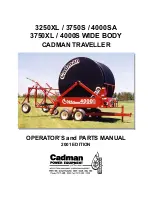
CL Series Filter System
Operating & Maintenance Manual
PEP Filters
•
322 Rolling Hill Road
•
Mooresville, NC 28117
•
800-243-4583
•
www.pepfilters.com
5 of 17
Rev. 030702
Note
: The ¾” (20 mm) drain plug on CL units is located on the tank bottom.
Actuator Requirements
PEP CL filters utilize electric actuators to control the valve action between the
filtration and backwash cycles. The electric actuator is designed for 110 VAC control.
Air operated actuators are available as an option.
Wiring
CL filters are supplied with a pump and automatic backwash controls and the
following system components: NEMA 4X (IP32) control enclosure containing an
on/off disconnect switch, motor overload protection, transformer to provide 110 VAC
control voltage, adjustable backwash timer, 24 hour time clock, pressure differential
switch to initiate backwash, valve actuator to reposition valves for backwash, and
push button for manual backwash initiation. Units are provided with 460 VAC, 3
φ
close-coupled pump/motor assembly (110 VAC single phase panel if pump is not
furnished).
Units supplied with city or other source backwash are provided with a magnetic
motor starter. Units supplied with manual backwash are provided with no motor
control.
The following recommendations conform to the 1993 national electric code. Check
with local, county, or other government authorities for prescribed requirements.
Note
: Refer to the pump/motor nameplate for horsepower and current draw.
Single Phase Manual Units
1. Install a separate power supply with circuit breaker protection between the
closest branch distribution panel and the pump motor. The full load current
for standard models is listed in Table 4.
2. Install an externally operated switch with fuse protection and door interlock in
plain sight of the filter and not more than 50ft (15m) away. The thermal
overload protection, if required, must be sized for full load amp draw listed on
the pump motor nameplate.
Three Phase Manual Units
1. Install a separate power supply line with circuit breaker protection between
the closest branch distribution panel and the pump motor. The full load



































